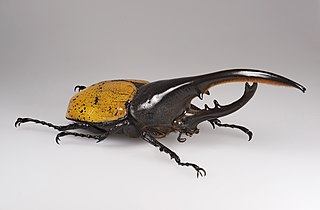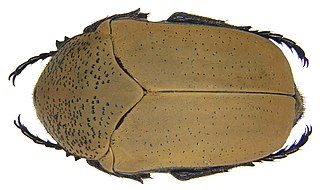
The family Scarabaeidae, as currently defined, consists of over 35,000 species of beetles worldwide; they are often called scarabs or scarab beetles. The classification of this family has undergone significant change in recent years. Several subfamilies have been elevated to family rank, and some reduced to lower ranks. The subfamilies listed in this article are in accordance with those in Catalog of Life (2023).

Scarabaeoidea is a superfamily of beetles, the only subgroup of the infraorder Scarabaeiformia. Around 35,000 species are placed in this superfamily and some 200 new species are described each year. Its constituent families are also undergoing revision presently, and the family list below is only preliminary. This superfamily includes some of the largest beetles extant today, including rhinoceros beetles, (Dynastinae), the Hercules beetle and Goliath beetles.

The Hercules beetle is a species of rhinoceros beetle native to the rainforests of southern Mexico, Central America, South America, and the Lesser Antilles. It is the longest extant species of beetle in the world, and is also one of the largest flying insects in the world.

Dynastinae or rhinoceros beetles are a subfamily of the scarab beetle family (Scarabaeidae). Other common names – some for particular groups of rhinoceros beetles – include Hercules beetles, unicorn beetles or horn beetles. Over 1500 species and 225 genera of rhinoceros beetles are known.

Dynastes tityus, the eastern Hercules beetle, is a species of rhinoceros beetle native to the Eastern United States. The adult's elytra are green, gray or tan, with black markings, and the whole animal, including the male's horns, may reach 60 mm (2.4 in) in length. The larvae feed on decaying wood from various trees.

The Sierra de Los Tuxtlas are a volcanic belt and mountain range along the southeastern Veracruz Gulf coast in Eastern Mexico. The Los Tuxtlas Biosphere Reserve includes the coastal and higher elevations of the Sierra de Los Tuxtlas.

Macrodontia cervicornis, also known as the sabertooth longhorn beetle, is one of the largest beetles, if one allows for the enormous mandibles of the males, from which it derives both of the names in its binomen: Macrodontia means "long tooth", and cervicornis means "deer antler". Measurements of insect length normally exclude legs, jaws, or horns, but if jaws are included, the longest known specimen of M. cervicornis is 17.7 cm; the longest known specimen of Dynastes hercules, a beetle species with enormous horns, is 17.5 cm, and the longest known beetle excluding either jaws or horns is Titanus giganteus, at 16.7 cm.

Chrysina, or jewel scarabs, is a genus of brightly colored, often metallic iridescent species of ruteline beetles. They range from the southwestern edge of the United States, through Mexico and Central America, and as far south as Colombia and Ecuador. Chrysina contains more than 120 species, includes all those formerly in the genus Plusiotis. The genus name is from Greek χρύσινος (chrysinos), "gold-coloured".

Dynastes is a genus of large beetles belonging to the family Scarabaeidae. They occur in the Nearctic realm and in the Neotropical realm, from the United States to Brazil; four North American species, three with distributions extending from Central America either north or south, and two species endemic to South America.

Scarabaeus sacer, common name sacred scarab, is the type species of the genus Scarabaeus and the family Scarabaeidae. This dung beetle is native of southern Europe, northern Africa and western Asia, and it was venerated in ancient Egypt.

Dynastes hyllus is a large scarab beetle species that ranges from Mexico to Guatemala. Its larvae have been found to associate with the logs of Persea americana.

Dynastes satanas, the Satanas beetle, is a species of beetle belonging to the family Scarabaeidae. The name is sometimes misspelled as "satanus".

The western Hercules beetle is a species of rhinoceros beetle that lives in Arizona, New Mexico and Utah in the United States and in parts of northern Mexico. This species is known for its grayish-white elytra, large size, and characteristic horn of the adult males.

Inca clathratus is a species of flower chafer in the family Scarabaeidae, indigenous to Central and South America. These beetles can be seen surrounding the sap flows from injured or diseased trees anytime in the day and sometimes at night. They mostly feed at the sap flows of the trees, including avocado and mango trees. Like other beetles they also feed off of rotting fruit. There are a few different subspecies of Inca clathratus including: Inca clathratus sommeri, Inca clathratus clathratus, and Inca clathratus quesneli. The species name has been frequently misspelled as "clathrata" but the genus name Inca is masculine.

Hologymnetis is a genus of fruit and flower chafers in the family Scarabaeidae. There are about eight described species in the genus Hologymnetis.

Chrysina lecontei, or Leconte's chrysina, is a species of shining leaf chafer in the family of beetles known as Scarabaeidae. It is found in southern United States and northern Mexico.

Chrysina beyeri, or Beyer's scarab, is a species of shining leaf chafer in the family of beetles known as Scarabaeidae. This bright green beetle is native to Chihuahua in Mexico and southeastern Arizona in the United States. It resembles C. woodi in both size and general appearance, but that species has green legs and blue tarsi.

Chrysina woodi, or Wood's jewel scarab, is a species of shining leaf chafer in the family of beetles known as Scarabaeidae. This bright green beetle is native to Chihuahua in Mexico, and New Mexico and Texas in the United States. This beetle is 25–35 mm (1.0–1.4 in) long and it resembles C. beyeri, but that species has all blue-purple legs and tarsi.

Dynastes neptunus is a beetle in the family Scarabaeidae. D. neptunus is very simular to the Hercules beetle but differs from it in slightly larger size and more of a slender and curved horns.
Dynastes maya, the Maya white beetle, is a species of New World scarab beetles (Scarabaeidae). It has a distribution range in the Central American region, specifically in southern Mexico, Honduras, and Guatemala.


















